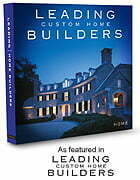How professional builders avoid some of the most common and costly construction mistakes.
But some less obvious details have as great an impact on the homeowners’ satisfaction over time. While homeowners have little control over these details, a professional builder with a sustainable business will make sure they get done right. Some areas that require special care and the services of a seasoned professional include…
Moisture Control Mistakes here can potentially raise the chance of mold, mildew, and rot. Steve Easley, a California-based building consultant who investigates moisture problems, sees the same errors again and again. Three common ones:
- Horizontal valleys. Such valleys include where a roof slopes into a chimney or wall. The detailing here needs to be close to perfect to keep water out.
- Lack of overhangs. In a Canadian study, 80 percent of examined homes with moisture in the walls had no roof overhang, making it easy for water to flow down the siding and into the wall.
- Improper housewrap. When water gets behind the siding, flashing and housewrap should direct it back out before it can get into the structure. Mistakes here are rampant. Take the example of a piece of flashing that laps over the one above it. Anyone with a basic grasp of gravity will understand that if water dripping down the wall hits this intersection, it will flow into the structure rather than out. Shockingly, building science experts say that it’s one of the most common errors they see in the field.
Mechanicals That Work
Modern heating and cooling equipment is very efficient, but efficiency doesn’t guarantee comfort. Equipment must be well sized and ducts properly sealed. Sadly, these aren’t always properly done.
Some HVAC contractors still use rule-of-thumb calculations to size furnaces and air conditioners. That may have worked for old, drafty structures but with today’s tighter homes the result is often oversized equipment that costs more to buy and operate, and leaves the home less comfortable than it could be. Smart builders hire an HVAC company that carefully calculates the home’s heating load and precisely matches the system to that load.
Another potential problem is leaky ductwork. If the leak is outside the main living area, such as in a basement, living and sleeping spaces won’t get the air they need. There will be resulting comfort issues, and the equipment will have to run longer to satisfy the thermostat. If ducts run through a totally unconditioned space—for example, a hot attic in summer—leaks will create a slight vacuum that pulls unwanted outside air into the house through leaks in the floors, walls, and ceilings.
Proper Insulation
When insulation is installed without enough attention to detail, the home can end up with hot and cold spots and uncomfortable drafts.
John Tooley, a nationally known building science consultant and energy expert, says that the most common problem areas he sees are attic knee walls (A knee wall is a short wall, typically under three feet in height, used to support the rafters) and vaulted ceilings. In the former the insulation usually gets installed without backing and so falls away from the wall; in the latter it’s stuffed into the ceiling cavity, leaving heat-sucking voids. “Insulation has to touch the surface of the drywall to do its job,” he points out. “That’s obviously not happening in a lot of cases.”
Make it a great day! 

David Baud CGR, CGB, CGP Baud Builders, Inc. PO Box 5708 Wakefield, RI 02880 (401) 789-1176 – Phone (401) 789-2258 – Fax
david@baudbuilders.com www.baudbuilders.com
November 2014
Copyright 2014. All rights reserved.









